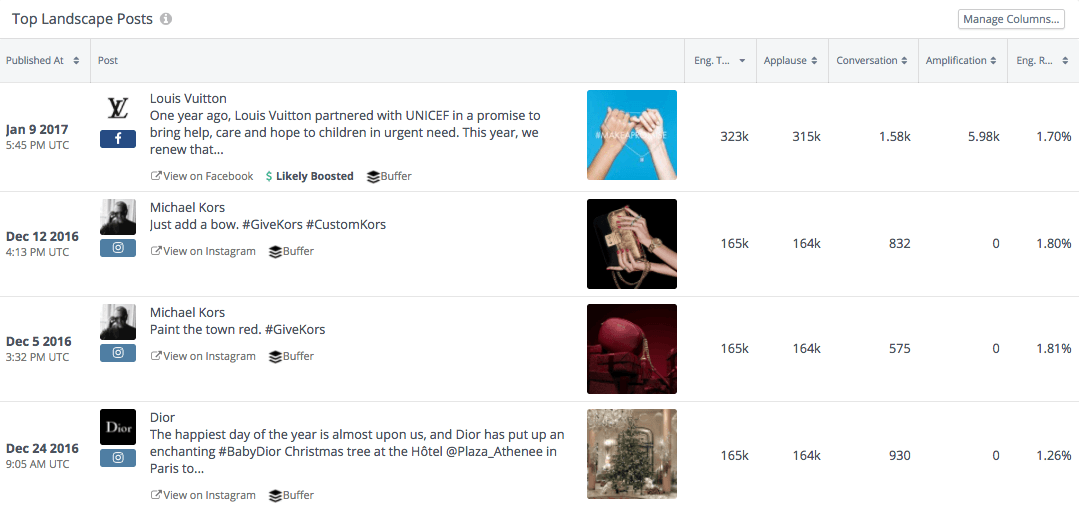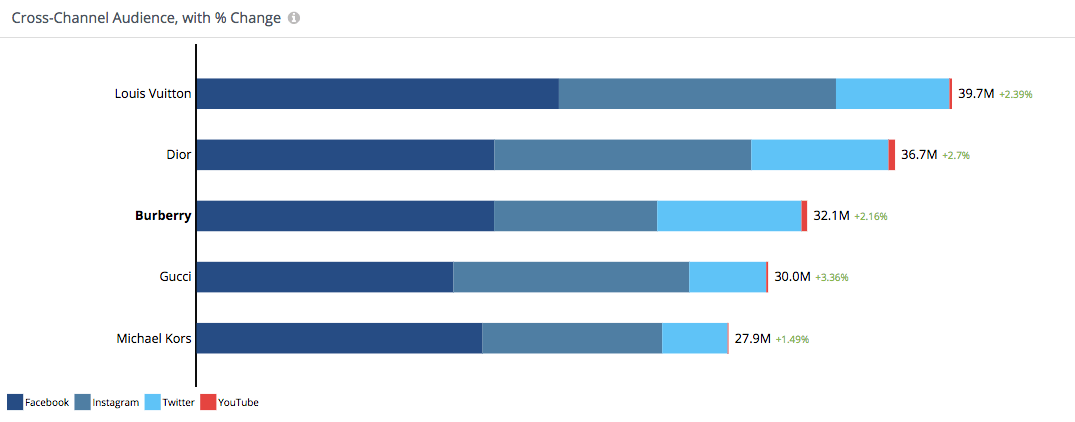Collecting all the social data you need to optimize your social media markering strategy can be a cumbersome process, but it doesn’t need to be.
You’ve made your argument to the executive team that social media plays a critical role in achieving your business goals. You’ve even convinced them to allocate some of the budget into social media activities to build and grow the ideas you brought to the table. Now that they’re excited, you have to maintain their support. To show progress on all the wonderful things you’ve promised to do, you need to tell a story, featuring numbers.
In this post, we cover the metrics that matter and how to give those numbers power to continue successfully leveraging social media for the business.
Metrics That Matter
Here are the key social metrics you can use to tell a story about the progress and success of your social media strategy.
Engagement
Engagement Rate
Engagement rate is the key metric in social that indicates success. Social engagement made up of interactions and interest in your brand. For instance, when someone likes, comments, or shares/retweets your post. Calculate engagement rate by the number of these events divided by the number of impressions your post has.
Engagement Rate/Post
Engagement rate per post standardizes your engagement so you can compare it to your past performance, competitors, and other organizations that are targeting the same audience as you. Often, only a small percentage of posts get an abnormally high amount of engagement while the rest of them get a steady, more predictable level. By averaging it out, you can cut through the performance variability of single posts and focus on increasing engagement overall whether you’re comparing to yourself in a previous time period, or to competitors in your landscape.

Types of Engagement
As mentioned, engagement is defined as “interactions and interest in your brand” that most social channels calculate by adding up your post’s likes, shares, and comments. These types of engagement should not be treated equally. Each of these social metrics is communicating something different.
- Like: A ‘like’ is pretty straightforward. Your audience is telling you that they are interested in what you’re posting and that they would like to see more content like this. If your goal is to increase engagement overall, earning likes is a great place to start.
- Comment: A comment carries more weight than a like because it takes more effort to comment on a post than to like a post. When your audience comments, they have read your content, thought about it, and taken the time to start a conversation with you about it. Depending on the sentiment, when a post gets comments, they’re telling you it’s thought provoking and they either really like or dislike your content. If your goal is to increase conversation with your audience, measuring comments will do you good.
- Share: A share also carries more weight than a like. Not only does it take more effort to share a post then to like it, your audience has found it valuable enough to share it with someone else they know in hopes that they will find value in it too. If your goal is to establish yourself as a thought leader, number of shares is a good indicator that you’re on the right track.
If you can elicit a good engagement rate on social media, it means your content is resonating with your audience. The higher your engagement rate, the more likely your audience is to be loyal to your brand and spend money with you.
Awareness
Fans/Followers
One way to track awareness is by your fan/follower growth (or loss). Simply plot the total number of people in your various social networks per period, and you can see how your fans and followers are trending.
Audience Growth Rate
Calculate audience growth rate by dividing new audience members by total audience members on each social channel. This way, you can see which channels are experiencing the highest and lowest levels of growth (or loss), helping you prioritize which channel to focus on first.
Mentions
Another way to measure awareness is by keeping track of the number of times your brand is mentioned online per a given period. You can use tools like Buzzsumo or Moz to listen for mentions across the internet or Rival IQ for mentions on social media.
Social audience growth indicates that your message is successfully making it past your current followers to new, relevant markets. Wider reach happens when your followers share your content to their networks, tag your organization in a post, when you use hashtags correctly, post in social communities, or when you boost posts or create social ads with proper targeting.
Reach
Post Reach
You know how many fans and followers you have, but not everyone in your social audience sees every post you create. Post reach is the estimated number of people who see a specific piece of content at least once during a given period.
Each social channel has a unique algorithm for deciding which of your posts reach a certain percentage of your audience. Keep an eye on your reach metric, and you’ll notice that different post types (status update, photo, video, live video, etc.) elicit different levels of reach. Take note and adjust your strategy to maximize your social reach.
It’s crucial to create a baseline of these social metrics for your organization because they’re most relevant when the time comes to tie social performance to high-level organizational goals. Communicate to leadership that these are the metrics that matter. Once everybody is aligned to what the important metrics are, what they tell us and how they impact the business, you need to be able to report on them on a regular basis.
Metrics That Tie Social To Revenue
Traffic & Conversions

Beyond social metrics, you need to be able to tie activities on social media to how they drive traffic to the website. If you can attribute a visitor on your website to a Facebook post, then you can demonstrate that your social media activities are getting the job done.
Google Analytics will tell us a range of things that will help you tie your social media efforts to revenue. They include:
- How many people are visiting your website?
- Which pages are they visiting?
- Are they bouncing?
- Where did they come from?
- Which social posts are getting people on your website (if you’re using UTM’s… use Google’s UTM Builder!)
- What content is driving sign ups?
Take this data will help you better understand how you’re interacting with that audience, the steps that they take once they’re on your website, and where you can improve your website to keep them there.
Powering Up Your Metrics
Competitive Benchmarking
Key performance indicators like Net Promoter Score, the number of clicks on a social post, or even a player’s batting average tells someone a lot about what is happening as a result of their activities. But it tells them nothing regarding whether their efforts are successful, failing, or where to focus on closing those gaps. Why? Because benchmarks are relative.
Incorporating benchmarks into your social reporting is crucial to outperforming your competitors on social media. You need to look at your competitors and other organizations targeting the same audience as you to establish context so that you get a baseline understanding of what they’re doing and how they’re performing on social media. You can discover your competitive benchmarks for free with Rival IQ.

Using Rival IQ, Burberry can see their social performance analytics compared to the averages of their direct competitors on their Instagram dashboard.
Example Scenario:
The head of marketing wants a report on social media activity. As a part of your report, you might say, “Hey, I’ve grown our social audience by 2%”. However, without context, they won’t understand if 2% is a good level of growth or not. If month over month audience growth in your competitive landscape is 5%, you’ve given that 2% metric context–you have room for improvement.
Conversely, you may find that your engagement rates are at 0.5%, which may not feel like success. However, looking at your competitors, you could find that they’re only getting 0.25% engagement rate. That casts your half a percentage point in a whole new light. Competitive benchmarking is important because it gives your social metrics context and meaning on an individualized level.
Results, Outcomes, and Benefits

It all comes down to telling the story of how social media has helped achieve business goals. If the organization is seeing progress in the right direction, tell the story of how social helped. Narrate how the leaps and bounds in audience size and online mentions have led to higher brand awareness. Or, how higher engagement and more social conversations have led to a higher Net Promoter Score. Maybe you’ve been able to show that a handful of campaigns last quarter drove X number of new sales opportunities. You have the data, now write the story that demonstrates impact.
Social media is a perfect place to test out new ideas. Some ideas work, but many don’t. If an initiative you sold to leadership turns out to be a dud, don’t stress! Discuss what you set out to do, what happened as a result, and most importantly what you learned. The primary focus should be talking about what your team learned and what iterations you plan to make next.
The ability to walk through the logic, track behaviors, and answer questions are key to effectively explaining the impact of social media. Data, a little bit of critical thinking, and a storyline are everything you need to justify social media.



